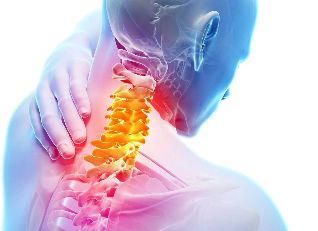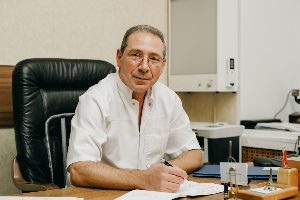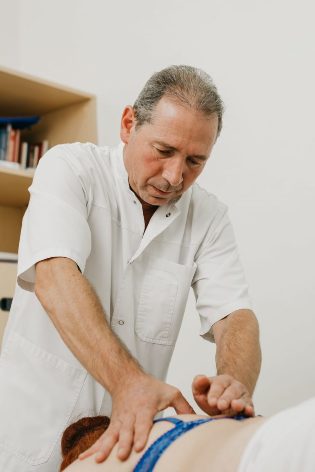In 70% of adults, the throat hurts at different intervals. At the same time, painful sensations can be not only of different nature, but also caused by a variety of diseases. Therefore, mainly they are not observed in isolation, but are accompanied by other symptoms that will help in the correct diagnosis and selection of the optimal tactics of treatment.
Types of neck pain

Neck pain can either be short-term and limited to minor complaints, or it can be very serious and have a significant impact on everyday life. More often, people complain that they suddenly feel lumbago, which is followed by persistent pain. It may be painful, tingling, throbbing, constricting, or otherwise.
Neck pain is also known as cervicalgia.
The symptoms usually increase during movement, e. g. B. when turning or tilting the head, while a static, particularly uncomfortable position is maintained over a long period of time, especially during long work on the computer. In this regard, a person is forced, often unconsciously, to turn their entire body around the neck as much as possible.
So it is obvious that neck pain can be very different. Therefore they are not only divided into acute (lasting less than 10 days) and chronic, but also into:
- vertebrogen - against the background of pathological changes in the cervical spine, including lesions of the intervertebral discs, compression of the roots of the spine and spinal cord;
- not vertebral - resulting from all other causes, including infectious diseases, inflammatory processes in the muscles, diseases of the thyroid gland, lymph nodes, etc.

Vertebrogenic pain is characterized by irradiation of the occipital area, shoulders, arms, up to the hands and fingers. Often numbness, impaired sensitivity and mobility are observed, which indicates the development of neurological disorders, that is, a violation of one or another anatomical structure of the nerve roots or spinal cord. Dizziness, attacks of loss of consciousness, and headache may also be observed in such situations, which indicate compression of the vertebral arteries, such as an intervertebral hernia.
It is imperative to make an appointment with a doctor if the neck pain is acute or accompanied by dizziness, numbness in the back of the head or tinnitus.
Causes of neck pain
Sometimes it is difficult for patients to distinguish a sore throat independently from neck pain, as it can be so diffuse that the sensations are blurred and the entire throat appears to be sore. If this is accompanied by a sensation of sweat or itchy throat, an increase in body temperature, it may indicate laryngitis, SARS, sore throat, pharyngitis, and other colds. These symptoms are also typical for:
- gastroesophageal reflux;
- Itsenko-Cushing syndrome;
- Foreign bodies entering the pharynx, e. g. B. Herringbone;
- hypovitaminosis;
- Formation of benign and malignant tumors in the throat.
Still, in most cases, people can distinguish neck problems from real neck pain, which can be seen on the anterolateral surfaces as well as back and front.
The localization of pain is an important diagnostic function with which you can determine the source of pain at the stage of the examination and then thoroughly examine the changes that have occurred using instrumental diagnostic methods.
Neck pain: cause
The occurrence of uncomfortable or even painful sensations directly in the area under the chin or diffuse pain throughout the neck area can indicate the following:
- thyroid disease;
- inflammatory processes in muscles affecting ligaments and nerves;
- Formation of cysts and abscesses;
- disease of the lymph nodes;
- angina pectoris.

That is, the list of possible causes is quite extensive and it is impossible to independently determine what exactly caused the pain in the neck. In such situations, it is worth contacting a therapist for an examination. If necessary, the doctor will refer the patient to a close specialist with the desired profile.
Vertebral artery syndrome and radicular syndrome can also be associated with anterior neck pain. In both cases, the cause is an entrapment of blood vessels or nerves by a deformed disc, oedematous tissue, a dislocated cervical vertebra or other structure. Our clinic has developed a comprehensive approach to solving this problem - experienced chiropractors, neurologists, rehabilitologists and endocrinologists will conduct an examination and prescribe the necessary treatment.
Neck pain: cause
Because of the peculiarities of modern lifestyle, very often people are concerned about pain in the neck. Working on the computer, constant use of equipment, low physical activity and bad habits lead to pathological changes in the structure of the spine, which are explained by neck pain. Therefore, in the event of pain, pulling, severe pain and lumbago in the neck, it is necessary to first consult a chiropractor or vertebrologist, as in the vast majority of cases this indicates diseases of the cervical spine, namely:
- Osteochondrosis is a widespread disease that is accompanied by degenerative-dystrophic changes in the intervertebral discs, a decrease in their size and a decrease in strength.
- protrusion - a complication of osteochondrosis, in which the intervertebral disc protrudes (more often into the spinal canal, where the spinal cord and nerve roots run), which creates the risk of pinching the nerves and vertebral arteries;
- Intervertebral hernias are a result of the lack of protrusion treatment, in which the internal contents of the disc penetrate the spinal canal, gradually increase in size, and can seriously compress the nerves and spinal cord. At the last stage of development, they separate and "migrate" along the spinal canal, which causes the most serious. and sometimes irreversible complications up to paralysis;
- Spondylosis is a complication of osteochondrosis in which bony protrusions, called osteophytes, grow along the edges of the vertebral bodies and the intervertebral discs are critically flattened, ultimately leading to the fusion of adjacent vertebrae and limiting neck mobility.
- myofascial syndrome - a disease in which individual muscles cramp, leading to attacks of acute pain during physical activity or when pressing certain points on the neck;
- Compression fractures of the vertebrae - most common in the elderly with osteoporosis or as a result of whiplash injury, such as an accident, and pose a serious threat to human life and health;
- Ankylosing spondylitis is a systemic disease that affects almost all joints in the body and, due to the merging of individual vertebrae, leads to strong and immobile conglomerates.
Much less often, neck pain is caused by spinal tuberculosis, osteomyelitis or Reiter's syndrome.
Neck pain: causes

Most commonly, pain in the sides of the neck is burning or throbbing, and they may also tingle. They tend to give on the shoulder and ear, sometimes accompanied by the formation of a secondary torticollis, causing the head to tilt toward the affected side. This is typical for:
- pathologies of blood vessels, including atherosclerosis;
- muscle spasms, which can be triggered by excessive strain on the neck, sudden movement or hypothermia;
- Formation of malignant formations in the thyroid, pharynx and larynx.
Diagnosing the causes of neck pain
Since, in the vast majority of cases, neck pain is caused by the development of pathologies in the cervical spine, you should consult a chiropractor, vertebrate, or neurologist if it occurs. The doctor can use the complaints, examination data and neurological tests presented to determine whether the complaints in the neck are actually due to diseases of the spine or to other diseases.
Nevertheless, it is the deviations from the norm in the state of the spine that actually represent one of the reasons for the development of concomitant diseases of the internal organs. After all, a change in the position of the vertebrae, a decrease in the height of the intervertebral discs and other, even minor, changes lead to a violation of the transmission of nerve impulses from the spinal cord through the nerve roots along the nerves to the internal organs.
Since the spinal cord is characterized by segmental innervation, i. e. each part of it is responsible for the correct functioning of a certain organ, the innervation of the ENT organs, vocal cords, thyroid glands and parathyroid glands can also suffer in the case of disorders of the cervical spine, as well as muscles in the neck, shouldersand forearms. Therefore, at first their work is interrupted, and over time, organic changes appear, that is, this or that disease develops, which can provoke pain in the neck of different intensity and character.
Therefore, diseases of the internal organs are rarely diagnosed and changes in the spine are not recognized. Therefore, it is imperative to consult a chiropractor. However, if the patient has signs of diseases of the thyroid gland, heart, ENT organs or others, he will also be shown to be advised by narrow specialists (endocrinologist, cardiologist, ENT doctor, etc. ).

Therefore, diagnosing the causes of neck pain is always complex. It can contain:
- general and biochemical blood tests;
- Determination of the level of thyroid hormones in the blood;
- Ultrasound with dopplerography of the vessels of the neck, thyroid, salivary glands;
- X-ray of the cervical spine;
- electroneuromyography;
- CT;
- MRI.
In order to diagnose pathologies of the spine, MRI, ie magnetic resonance tomography, is the most informative. This method can be used to examine the condition of the intervertebral discs in minute detail, assess the quality of blood flow in the vertebral arteries, and identify signs of compression of the spinal cord or its roots. With its help, diseases are diagnosed at the earliest stages of development, which ensures the earliest possible start of treatment and its high efficiency.
In our clinic you will also learn more about the composition of your body and the condition of the vascular system that is involved in the blood supply to the internal organs, the muscles of the musculoskeletal system and the brain. Our experienced doctors explain the results to you in detail. Bioimpedansometry calculates the ratio of fat, muscle, bone and skeletal mass, total body fluid and basal metabolic rate. The intensity of the recommended physical activity depends on the state of the muscle mass. Metabolic processes, in turn, affect the body's ability to recover. Based on the indicators of the active cell mass, the level of physical activity and nutritional balance can be assessed. This simple and quick test will help us identify endocrine disorders and take action. In addition, it is very important for us to know the condition of blood vessels in order to prevent diseases such as heart attack, high blood pressure, heart failure, diabetes mellitus, and many more. With Angioscan you can determine such important indicators as the biological age of blood vessels, their stiffness, the stress index (which speaks of the heart rate) and blood oxygen saturation. Such screening is useful for men and women over 30, athletes, those who are undergoing long and difficult treatment, as well as anyone who monitors their health.
In this case, the analysis of the body composition provides the information that the body is dominated by adipose tissue and that the bone-muscle component shows a relative deficit. These data will help the rehabilitation doctor correctly draw up a plan for physical activity, taking into account the individual characteristics of the patient.
Treatment of neck pain
For each patient, the therapeutic tactics are developed strictly individually on the basis of the diagnosis, the severity of pathological changes, the presence of concomitant diseases and other factors. Different treatments may be prescribed even to patients with the same disabilities as this is also influenced by age and physical development.
Nevertheless, the treatment of diseases that cause neck pain is always complex and includes both symptomatic and etiotropic therapy. In other words, it aims to get rid of the symptoms of the disease and the causes of its occurrence. The main components of therapy are often:
- drug treatment;
- osteopathy;
- manual therapy;
- massage;
- Physiotherapy (phonophoresis, carboxytherapy, ozone therapy, pressotherapy HF currents);
- One-to-one lessons with a rehabilitation doctor.

When diagnosing pathologies of the cervical spine, it is shown that some adjustments are made to your lifestyle and habits. Office workers, drivers, seamstresses and representatives of other sedentary professions are therefore advised to warm up as often as possible and avoid long-term maintenance of a forced posture, especially when the neck muscles need to be tensed.
It is also important to eat right so that the body gets all the nutrients it needs. This will not only slow down the progression of the pathology, but also contribute to a faster course of the regeneration processes.
If the pain is severe, the chiropractor can recommend the patient to buy a neck brace or a Chance collar. Wearing it will help relieve the strain on the cervical spine and avoid rashes and sudden movements that will gradually fade the pain syndrome. In our center you can choose and buy a dressing that suits you
You can wrap a woolen scarf around your neck before your appointment to relieve pain, or you can take an anesthetic pill at least 12 hours before taking it.
drug therapy
The type of medication prescribed and its amount can vary within a very wide range, which depends directly on the diagnosis and the presence of comorbidities. Therefore, we only list the groups of drugs that are prescribed to the vast majority of patients:
- NSAIDs are nonsteroidal anti-inflammatory drugs that also differ in their analgesic properties (made in different dosage forms, including tablets, ointments, solutions for injection, etc. ).
- Corticosteroids are drugs with a powerful anti-inflammatory effect that are used only in severe inflammatory processes that NSAIDs cannot eliminate.
- muscle relaxants - drugs that eliminate muscle spasms of various origins and help reduce the severity of pain;
- chondroprotectors - drugs that promote the restoration of the cartilage tissue that makes up the intervertebral discs, but they are effective only in the initial stages of osteochondrosis;
- B vitamins - are used to improve the transmission of bioelectrical impulses from the spinal cord to the corresponding organs and restore their correct function.
- Vitamin D - a compound that is responsible for the condition of bone tissue, as well as for higher brain functions such as memory, memory, attention and language.
In addition, patients may be prescribed antibiotics, hormone replacement therapy, antihypertensive drugs, and others.
Blockages are used for particularly severe neck pain. The procedures involve injecting corticosteroids in anesthetic solutions into the area where the nerves run in the neck, which allows for very quick pain relief. In addition to being effective only on pain caused by nerve damage, they require a high level of professionalism from medical professionals, since if there is a blockage, there is a risk of nerve injury, infection and serious complications.
Manual therapy
Manual therapy is one of the most effective methods of dealing with neck pain and its causes, but only if done correctly. It directly affects the spine and surrounding soft tissues. Do not confuse manual therapy with therapeutic massage, which only trains the back and neck muscles.

Techniques and methods of manual therapy literally make it possible to achieve a significant improvement in well-being and ultimately a complete remission after the first session. This is achieved by:
- Restoration of the normal spinal axis by returning the vertebrae to their anatomically correct position;
- increasing the distance between the vertebral bodies and releasing compressed nerves and blood vessels, eliminating the signs of radicular syndrome and improving the functioning of internal organs, and especially the brain;
- Elimination of spasms in the neck muscles and functional blocks that improve mobility and reduce the severity of pain;
- improves blood circulation and tissue nutrition.
We do not have a common treatment standard, each patient is treated individually. Only a highly qualified specialist should be trusted to perform manual therapy. Otherwise, the use of inappropriate techniques can only harm the patient, worsen the problem or provoke the development of complications.
Physiotherapy
Physiotherapy procedures are used to improve the effectiveness of therapy. They are only shown outside of the acute period and have an analgesic, anti-inflammatory effect, improve microcirculation in soft tissues and help normalize muscle tone.
Usually courses are prescribed that consist of 8-15 procedures. These can be:

- electrophoresis;
- UHF;
- ultrasound therapy;
- laser therapy;
- traction therapy (spinal traction);
- Mud baths etc.
The number of sessions of physiotherapy procedures and the frequency of their implementation are selected by the doctor individually. Some procedures can be combined with each other, while others should be carried out strictly at a certain interval.
Movement therapy
Physiotherapy is one of the essential components of conservative therapy for neck pain. Since they very often occur against the background of muscle overload and the resulting degenerative-dystrophic processes in the intervertebral discs, it is important to pay due attention to exercise therapy and daily training.
A rehabilitation doctor develops a program with physiotherapy exercises separately for each patient. The use of the complexes presented on the Internet can be dangerous, as they do not take into account the individual characteristics of the patient, his age, the degree of neglect of the pathological process and the physical fitness of the patient. Developing an exercise therapy program therefore requires the help of a specialist. In addition, the first few sessions are necessarily carried out under his control, so that the patient can understand how to perform each exercise and not harm himself in the course of self-study. At home, practice in a quiet environment and avoid sudden movements. If you experience pain, you should consult a doctor.
Therefore, neck pain is common. They can be caused by developing various diseases, but most often spinal problems caused by a sedentary lifestyle are the basis of the ailments. That is why you should not hesitate to consult a doctor. In fact, in the early stages of the development of the disease, it is easy to deal with conservative methods. In advanced cases, neck pain and its causes can only be removed by surgery.



























